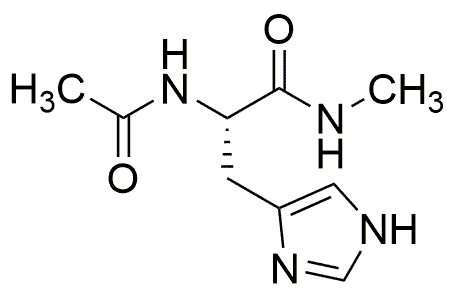Na-Acetyl-L-histidine methyl amide is widely utilized in research focused on:
- Biochemical Research: This compound serves as a valuable tool in studying histidine metabolism and its role in various biological processes, aiding researchers in understanding cellular functions.
- Pharmaceutical Development: It is explored for its potential therapeutic effects, particularly in neuroprotection and anti-inflammatory applications, making it relevant for drug formulation in the pharmaceutical industry.
- Nutrition Science: Researchers investigate its impact on amino acid profiles in dietary supplements, contributing to advancements in nutritional science and health products.
- Cosmetic Formulations: The compound is being studied for its antioxidant properties, which can enhance skin health and appearance, appealing to the cosmetics industry.
- Analytical Chemistry: It is used as a reference standard in chromatographic techniques, ensuring accuracy in the analysis of complex mixtures in research laboratories.
Informations générales
Propriétés
Sécurité et réglementation
Applications
Na-Acetyl-L-histidine methyl amide is widely utilized in research focused on:
- Biochemical Research: This compound serves as a valuable tool in studying histidine metabolism and its role in various biological processes, aiding researchers in understanding cellular functions.
- Pharmaceutical Development: It is explored for its potential therapeutic effects, particularly in neuroprotection and anti-inflammatory applications, making it relevant for drug formulation in the pharmaceutical industry.
- Nutrition Science: Researchers investigate its impact on amino acid profiles in dietary supplements, contributing to advancements in nutritional science and health products.
- Cosmetic Formulations: The compound is being studied for its antioxidant properties, which can enhance skin health and appearance, appealing to the cosmetics industry.
- Analytical Chemistry: It is used as a reference standard in chromatographic techniques, ensuring accuracy in the analysis of complex mixtures in research laboratories.
Documents
Fiches de données de sécurité (FDS)
La FDS fournit des informations de sécurité complètes sur la manipulation, le stockage et l’élimination du produit.
Spécifications du produit (PS)
Le PS fournit une description complète des propriétés du produit, notamment sa composition chimique, son état physique, sa pureté et les exigences de stockage. Il détaille également les plages de qualité acceptables et les applications prévues du produit.
Certificats d'analyse (COA)
Recherchez des certificats d'analyse (COA) en saisissant le numéro de lot du produit. Les numéros de lot et de lot se trouvent sur l'étiquette d'un produit, après les mots « Lot » ou « Lot de fabrication ».
Numéro de catalogue
Numéro de lot/série
Certificats d'origine (COO)
Ce certificat d'exploitation confirme le pays dans lequel le produit a été fabriqué, et détaille également les matériaux et composants utilisés et s'il est issu de sources naturelles, synthétiques ou autres sources spécifiques. Ce certificat peut être requis pour les douanes, le commerce et la conformité réglementaire.
Numéro de catalogue
Numéro de lot/série
Fiches de données de sécurité (FDS)
La FDS fournit des informations de sécurité complètes sur la manipulation, le stockage et l’élimination du produit.
DownloadSpécifications du produit (PS)
Le PS fournit une description complète des propriétés du produit, notamment sa composition chimique, son état physique, sa pureté et les exigences de stockage. Il détaille également les plages de qualité acceptables et les applications prévues du produit.
DownloadCertificats d'analyse (COA)
Recherchez des certificats d'analyse (COA) en saisissant le numéro de lot du produit. Les numéros de lot et de lot se trouvent sur l'étiquette d'un produit, après les mots « Lot » ou « Lot de fabrication ».
Numéro de catalogue
Numéro de lot/série
Certificats d'origine (COO)
Ce certificat d'exploitation confirme le pays dans lequel le produit a été fabriqué, et détaille également les matériaux et composants utilisés et s'il est issu de sources naturelles, synthétiques ou autres sources spécifiques. Ce certificat peut être requis pour les douanes, le commerce et la conformité réglementaire.


